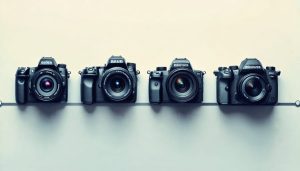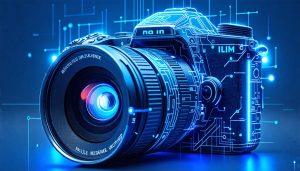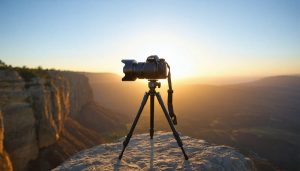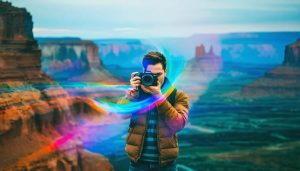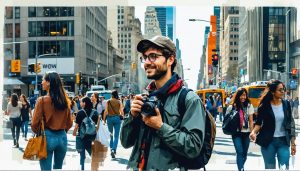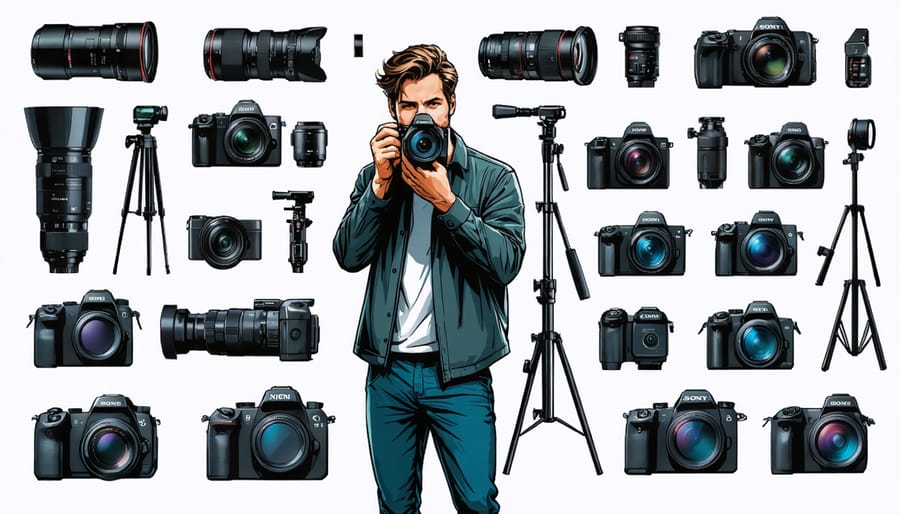
Determine your primary use case: identify whether photography or videography will be your main focus. Consider key features like sensor size, autofocus system, video resolution and frame rates, and low-light performance that align with your priorities. Evaluate top camera models from respected brands such as Sony, Canon, and Nikon, comparing their specifications, ergonomics, and price points to find the best fit for your needs and budget. Invest in high-quality lenses that complement your chosen camera body, prioritizing versatile zoom ranges and wide apertures for flexibility and creative control. Don’t forget about essential accessories like sturdy tripods, external microphones, and lighting equipment to elevate your photography and videography game. By carefully assessing your requirements and selecting gear that excels in both still and motion capture, you’ll be well-equipped to create stunning visuals across all your creative pursuits. For those primarily interested in motion capture, our guide to the best video cameras offers tailored recommendations.

Key Features to Look for in a Hybrid Camera
Sensor Size and Resolution
The sensor size and resolution of a camera play a crucial role in determining image quality for both photos and videos. A larger sensor size allows more light to be captured, resulting in better low-light performance, wider dynamic range, and improved color depth. This means that cameras with larger sensors, such as full-frame or APS-C, generally produce higher-quality images compared to those with smaller sensors like micro four-thirds or 1-inch.
Resolution, measured in megapixels, determines the level of detail that can be captured. Higher resolution cameras allow for larger prints and more flexibility in cropping without sacrificing image quality. However, it’s important to note that resolution isn’t the only factor affecting image quality; the sensor’s technology and the lens quality also play significant roles.
When it comes to videography, sensor size and resolution impact the camera’s ability to capture high-quality footage with shallow depth of field and low noise levels. Many modern cameras offer 4K video recording, which provides exceptional detail and clarity. Some high-end models even support 6K or 8K resolution for the most demanding professional applications.
Autofocus System
A camera’s autofocus system plays a crucial role in capturing sharp, in-focus images and videos. Look for cameras with fast, accurate autofocus that can keep up with your subjects, even in challenging lighting conditions. Dual Pixel AF, found in many Canon cameras, and on-sensor phase detection AF, used by Sony and others, are among the quickest, most reliable focusing technologies.
Consider the number of autofocus points, as more points generally mean better coverage and tracking capabilities. Cameras with touch-to-focus features allow you to intuitively select your focus point on the LCD screen. For video, a camera with smooth, silent autofocus is ideal to avoid distracting noise and focus hunting during recording.
Some cameras offer eye and face detection AF, which can be invaluable for portrait photography and videography. Ultimately, a responsive, customizable autofocus system will help you nail focus consistently, ensuring your creative vision shines through in every shot.
Video Specifications
When evaluating a camera’s video capabilities, resolution is a key factor. Look for cameras that offer 4K video recording, which provides four times the detail of Full HD. Some high-end models even support 6K or 8K resolution. Frame rates also matter – 24 fps provides a cinematic look, while 60 fps enables smooth slow-motion playback. Codecs like H.264 and H.265 ensure efficient compression without sacrificing quality. In-body image stabilization helps minimize camera shake for smoother handheld footage. Other useful video features include external mic input, HDMI output, and a flip-out LCD screen for easy framing at various angles.

Top Cameras for Photography and Videography
Sony A7 IV
The Sony A7 IV is a highly capable full-frame mirrorless camera that excels in both photography and videography. Boasting a newly developed 33MP BSI CMOS sensor and the powerful BIONZ XR image processor, this camera delivers exceptional image quality with stunning detail and low-light performance. The A7 IV’s advanced autofocus system, featuring 759 phase-detection AF points and real-time tracking, ensures precise and reliable focus for both stills and video.
One of the standout features of the A7 IV is its impressive video capabilities. It can record 4K video at up to 60fps with full pixel readout, providing sharp and detailed footage. The camera also supports a variety of professional video features, such as S-Log3, HLG, and 10-bit 4:2:2 color sampling, making it a versatile tool for content creators and filmmakers.
The A7 IV’s 5-axis in-body image stabilization system helps minimize camera shake, allowing for sharp images and smooth video footage even when shooting handheld. The camera’s ergonomic design, including a large grip and customizable buttons, enhances handling and user experience.
While the A7 IV offers an impressive feature set, it does have some limitations. The camera’s menu system can be complex and may require some time to master. Additionally, the high-resolution sensor and advanced video features can result in large file sizes, requiring ample storage space and fast memory cards.
Overall, the Sony A7 IV is a well-rounded camera that delivers excellent performance for both photography and videography, making it a top choice for enthusiasts and professionals alike.
Canon EOS R6
The Canon EOS R6 is a powerful and versatile full-frame mirrorless camera that excels in both photography and videography. With a 20.1-megapixel CMOS sensor and Canon’s advanced DIGIC X image processor, the R6 delivers stunning image quality with excellent low-light performance. It boasts an impressive autofocus system with 1,053 AF points, covering nearly 100% of the frame, ensuring precise and fast focusing even in challenging situations.
For photographers, the EOS R6 offers continuous shooting speeds of up to 12 frames per second with the mechanical shutter and 20 frames per second with the electronic shutter, making it ideal for capturing fast-moving subjects. The camera’s In-Body Image Stabilization (IBIS) provides up to 8 stops of stabilization, allowing for sharp handheld shots even in low light.
Videographers will appreciate the R6’s ability to record 4K video at up to 60 frames per second and Full HD at up to 120 frames per second, enabling smooth slow-motion footage. The camera supports 10-bit 4:2:2 color sampling and Canon Log, providing greater flexibility in post-production. With dual card slots (SD and CFexpress), the R6 ensures ample storage space and redundancy for important shoots.
The Canon EOS R6 is a well-rounded camera that delivers professional-level performance in a compact and user-friendly package, making it an excellent choice for photographers and videographers alike.
Fujifilm X-T4
The Fujifilm X-T4 is a highly capable APS-C mirrorless camera that seamlessly combines retro charm with modern features, making it an attractive option for photographers and videographers alike. Its 26.1-megapixel X-Trans CMOS 4 sensor and X-Processor 4 deliver stunning image quality with excellent color reproduction and low-light performance. The X-T4’s 5-axis in-body image stabilization (IBIS) provides up to 6.5 stops of shake reduction, enabling sharper images and smoother video footage, even when shooting handheld.
For videographers, the X-T4 offers impressive capabilities, including 4K video recording at up to 60 frames per second and Full HD at up to 240 fps for slow-motion playback. The camera also supports 10-bit 4:2:0 internal recording and 4:2:2 output via HDMI, providing greater flexibility in post-production. Additionally, the X-T4 features a fully articulating touchscreen LCD, which is particularly useful for shooting video from various angles.
The camera’s autofocus system is fast and accurate, with face and eye detection for both stills and video. The X-T4 also boasts a high-speed continuous shooting rate of up to 15 fps with the mechanical shutter and 20 fps with the electronic shutter, making it well-suited for capturing fast-moving subjects.
Fujifilm’s renowned Film Simulation modes are present in the X-T4, allowing users to recreate the look of classic film stocks, adding a unique character to their images and videos. The camera’s weather-sealed body and durable construction make it suitable for use in various environments, while its dual SD card slots provide ample storage and backup options.

Lenses and Accessories for Versatile Shooting
Zoom Lenses
When it comes to versatility, zoom lenses are a photographer’s best friend. They allow you to capture a wide range of focal lengths without the need to switch lenses constantly. For photography and videography, consider a standard zoom like a 24-70mm f/2.8, which covers wide-angle to short telephoto ranges. This is perfect for landscapes, portraits, and everyday shots. If you need more reach, a 70-200mm f/2.8 is ideal for sports, wildlife, and tight close-ups. For those who want an all-in-one solution, superzoom lenses like a 28-300mm offer an extensive range, albeit with some compromise in image quality and aperture. When selecting zoom lenses, look for ones with fast, constant apertures throughout the zoom range, as well as image stabilization for sharper handheld shots and smoother video. Remember, investing in quality glass will elevate your photography and videography to new heights.
Prime Lenses
Fast prime lenses offer several advantages for photography and videography, especially in low light situations. With wider maximum apertures like f/1.4 or f/1.8, prime lenses allow more light to reach the sensor, enabling shorter shutter speeds and lower ISO settings. This is crucial for capturing sharp images in dimly lit environments without a flash. Additionally, the wide apertures of prime lenses create a shallow depth of field, producing the coveted bokeh effect – a creamy, out-of-focus background that makes subjects pop. While zoom lenses offer flexibility, the superior optical quality and low light performance of prime lenses make them essential tools for serious photographers and videographers.
Gimbals and Tripods
Gimbals and tripods are essential tools for capturing smooth, stable video footage. Gimbals use motors and sensors to counteract camera shake, allowing for fluid movement while maintaining a steady shot. They’re ideal for action shots, tracking subjects, or creating cinematic effects. Tripods provide a static base to eliminate unwanted vibrations and enable precise framing. They’re perfect for interviews, time-lapses, or low-light situations requiring longer exposures. Investing in quality stabilizing gear can significantly enhance your video production value, giving your footage a professional polish. Consider your shooting style and needs when choosing between a gimbal for mobility or a tripod for stability.
In conclusion, selecting the best camera for photography and videography ultimately depends on your specific needs, skill level, and budget. Consider the key factors we’ve discussed, such as sensor size, resolution, autofocus capabilities, and video features when making your decision. While high-end models like the Sony A7 IV and Canon EOS R5 offer exceptional performance, there are also excellent options in the mid-range and entry-level categories that can deliver outstanding results. Don’t forget to invest in quality lenses and essential accessories to maximize your camera’s potential. As you gain experience and refine your style, you may find that your camera requirements evolve. Remember, the best camera is the one that enables you to capture your creative vision and grow as a photographer and videographer. With the right tools and dedication, you’ll be well on your way to producing stunning images and videos.

